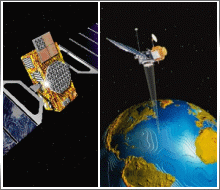
Space systems
 The interest in this research area regards multimedia platforms based on the integration of terrestrial broadband
(both fixed and radio mobile) and satellite segments. Main research topics are: QoS (Quality of Service) guarantees
to multimedia traffic with both stringent real-time constraints (such as, for example, voice and video) and non
real-time characteristics (such as, for example, Web Traffic) in Geostationary Satellite platforms, integration of
ATM protocol into satellite platforms, Internet protocol (TCP/IP) extension to symmetric and asymmetric satellite
platforms.
The interest in this research area regards multimedia platforms based on the integration of terrestrial broadband
(both fixed and radio mobile) and satellite segments. Main research topics are: QoS (Quality of Service) guarantees
to multimedia traffic with both stringent real-time constraints (such as, for example, voice and video) and non
real-time characteristics (such as, for example, Web Traffic) in Geostationary Satellite platforms, integration of
ATM protocol into satellite platforms, Internet protocol (TCP/IP) extension to symmetric and asymmetric satellite
platforms.At the same time, issues relevant to the extension of QoS paradigms (both network-level and perceptual QOS) into the IP environment, traditionally thought only for best-effort applications, are addressed. By starting from the definition in the literature of QoS models, such as DiffServ ed IntServ, which have been specifically conceived for a fixed-network environment, their extension to integrated environment of the IP-satellite type is investigated. HAPs, High Altitude Platforms, and their role within integrated space and terrestrial systems is a focus of the research as well as the techniques for the access control, mobility management and resource allocation in satellite systems with DVB-RCS (Digital Video Broadcasting-Return Channel via Satellite) standard.
Such a kind of research activities have been conducted within the framework of projects partially funded both by the ASI (Italian Space Agency) and by ESA (European Space Agency). Cited activities have enabled the participation into the definition and development process of integrated asymmetrical space and terrestrial architectures equipped with QoS control mechanisms, as well as of techniques of Call Admission Control e Medium Access Control for next generation asymmetrical (such as SkyplexNet over Hot-bird5) and symmetrical (such as EuroSkyWay and SkyplexNet over Hot-bird 6) GEO platforms based on ATM (Euroskyway) and DVB-RCS (Skyplexnet).
Research activities
Space and terrestrial segment integration:
- QoS metric definition for performance evaluation in integrated terrestrial-satellite scenarios.
- Integration of satellite sytems and High Altitude platforms (HAPs) to support multicast and broadcast multimedia applications.
- Solutions for HAP integration into cellular in 3G and beyond-3G cellular systems optimized for Multicast traffic delivery and based on MBMS (Multimedia Broadcast and Multicast Services) architectures.
- Design of novel protocols for CAC (Connection Admission Control) and TRM (Traffic Resource Management), on-board scheduling, traffic shaping, e in-band/out-of-band signaling to effectively support the transmission of data with differentiated service guarantees in geostationary platforms.
- Design of MAC (Medium Access Contrl) protocols based on the dynamic frame dimensioning in TDMA based platforms and relevant studies on the forward and return link signalling bandwidth.
- Connection Admission Control (CAC) and Medium Access Control (MAC) for DVB-RCS systems based on multi-spot coverage and regenerative payloads.
- Medium Access Control (MAC) per sistemi DVB-RCS (SkyPlexNet/HotBird6 - HB6) basati sulla distribuzione degli algoritmi tra Hub e user e sulla possibilitÓ di ridistribuire dinamicamente la banda allocata ad un terminale tra le diverse componenti di traffico da questo originate.
- Algorithm for the effective management of resources allocated to the return channel of a DVB-RCS system supporting terminal mobility (adoption of techniques based on genetic algorithms, Fuzzy Logic, and Neural Networks).
Main Collaborations: UniversitÓ di Tor Vergata- Roma, UniversitÓ della Calabria - Cosenza, Politecnico di Torino; ASI, ESA, Space Engineering, Alenia Spazio, Telespazio, UniversitÓ di Trento, CREATE-NET, Politecnico di Milano,CNIT, University of Kosice.











